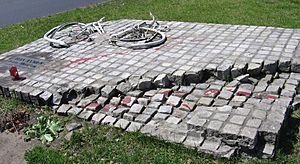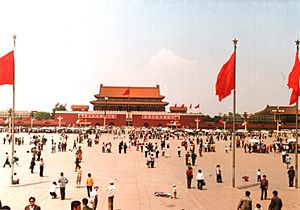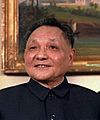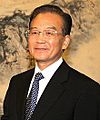Tiananmen Square protests of 1989 facts for kids
The 1989 Tiananmen Square protests were a series of large demonstrations in China in April and June 1989. Many people around the world call this event the Tiananmen Square massacre. In China, it is known as the June Fourth Incident.
What Happened at Tiananmen Square?
The 1989 protests were mainly led by students. They gathered to ask for more democracy, free speech, and a free press in China. There had been other protests in Tiananmen Square before, in 1919 and 1976.
The protests in 1989 involved students, thinkers, and workers. They did not all have the same goals or leaders. However, many protesters were unhappy with how the Communist Party was managing the country's economy. Some also wanted China to become more democratic.
Most of the protests happened in Beijing, especially in Tiananmen Square. But people also protested in other cities, like Shanghai. The protests outside of Beijing remained peaceful.
On June 4, 1989, the Chinese government used force to stop the protests. Many people were hurt or died. The exact number of victims is still not known today. The Chinese government said about 200 to 300 people died. Other sources, like The New York Times, reported between 300 and 800 victims. The Chinese Red Cross suggested 2,000 to 3,000.
The Chinese government stated that they had to end the protests to keep the country stable. Many scenes from the protests, including a famous image of a man standing in front of tanks, were shown around the world.
Why Did the Protests Happen?
There were several reasons for the protests. A big problem was corruption within the Communist Party. The way the economy was run was also causing problems. The country was still quite poor, and people living in cities felt this the most.

These events happened when Deng Xiaoping was in charge. He took over after Mao Zedong in 1978. Deng started big economic changes that helped farmers and people in the countryside. However, these changes were not as good for people in cities.
City workers, students, and thinkers worried about losing their jobs and facing social problems. They felt like they had no say in these issues. This made them feel powerless.
A key event that started the protests was the sudden death of Hu Yaobang on April 15, 1989. Hu was a reformer, meaning he wanted changes. His death caused students to gather in large numbers. On university campuses, many posters appeared, praising Hu and asking for his ideas to be brought back. Soon, these posters started talking about bigger issues like freedom of the press, democracy, and corruption.
Some people say these protests were one of the largest demonstrations for a specific cause in modern history.
Images for kids
-
Deng Xiaoping led China's economic changes starting in 1978.
-
Wen Jiabao met with students in the Square. He later became Premier of China.
-
In 1989, thinkers and a singer joined students for a hunger strike. Liu Xiaobo, who called for political reform, won the 2010 Nobel Peace Prize.
-
Soldiers used rifles like the Type 56 assault rifle (top) and AKS-47 (bottom) during the crackdown.
-
A Candlelight vigil in Hong Kong in 2009, 20 years after the June 4th incident.
See also
 In Spanish: Protestas de la plaza de Tiananmén de 1989 para niños
In Spanish: Protestas de la plaza de Tiananmén de 1989 para niños











